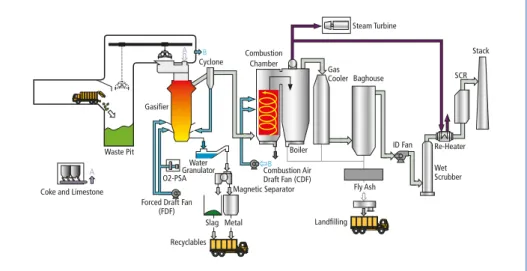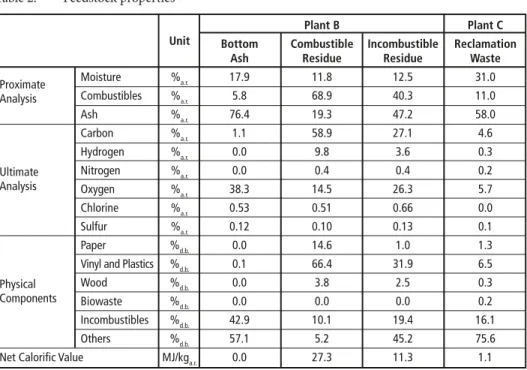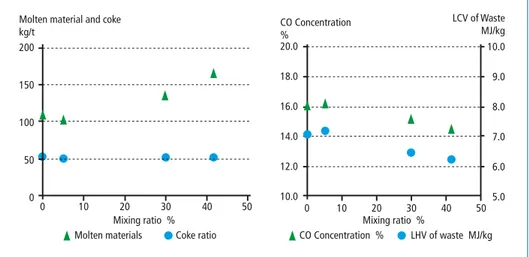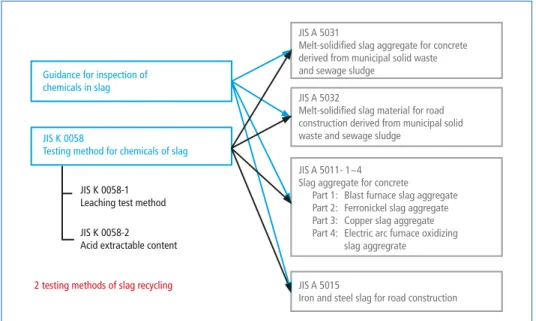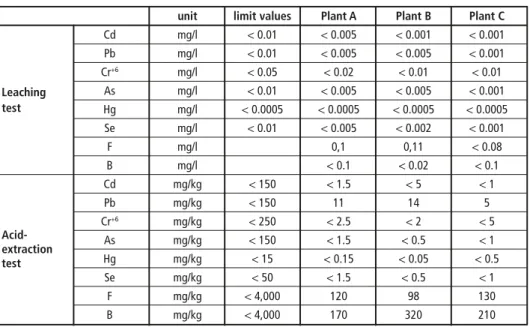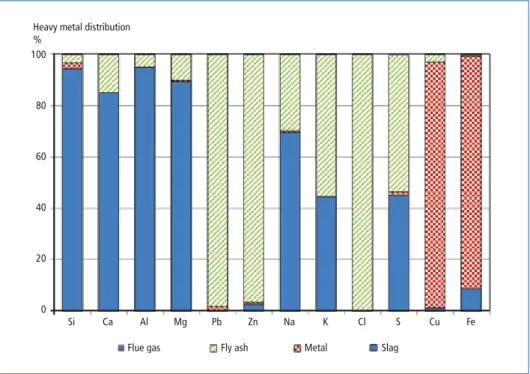Pyrolysis/Gasification
Resource Recovery from Waste Using the Input Flexibility of Waste Gasification Technology
Nobuhiro Tanigaki, Ryo Makishi and Toshimi Nagata
1. Materials and methods ...458
1.1. Process description ...458
1.2. Plant description ...459
1.3. Feedstock property...461
2. Results and discussion ...462
2.1. Operational results ...462
2.2. Slag quality ...463
2.3. Heavy metal distribution ...466
3. Conclusions ...467
4. References ...468 Nowadays, gasification of waste or biomass is becoming the great interest all over the world. Especially, gasification of municipal solid waste (MSW) has been well-researched in Japan. The development of MSW gasification technology was started in the 1970s in Japan because of oil crisis. Several technologies have been researched and developed.
The Direct Melting System (DMS), which is the gasification and melting technology developed by Nippon Steel & Sumikin Engineering Co., Ltd., is one of the developed waste gasification technologies in this era. This technology was introduced for commercial use in Kamaishi City, Japan in 1979. As well as this waste technology, other gasification technologies have been developed for commercial use and installed. Andco-Torrax system and Purox system were also employed as a gasification and melting technology for MSW. They were introduced in Hamamatsu City in 1980, and in Chichibu City in 1981, respectively. Dual fluidized bed gasifiers, was introduced in Funabashi City in 1979. At that time, almost the all gasification technologies have faced to operational difficulties and went out from the commercial market. Today, the DMS technology is still under operation until today.
This waste gasification technology with direct melting is a shaft-furnace type gasifi- cation and melting process and is classified as an atmospheric fixed bed gasifier. The gasification technology is in commercial operation at more than 45 plants in Japan and South Korea [5, 8, 12, 13]. Nowadays, this is also used for Tsunami waste and radio- active waste to reducing the final landfill amount.
Pyrolysis/Gasification
Waste to Energy (WtE), which indicates a power generation during waste processing, is a major interest especially in Europe. Many plants in Europe are focusing on the higher power generation or heat utilization. On the other hand, material recovery from wastes such as MSW and bottom ash is also becoming a major interest. Particularly, material recovery from MSW bottom ash is concerned [2, 4] as well as reclamation waste from a landfill site, because it contains some valuable material and heavy metals such as gold, copper and ferrous and non-ferrous materials. Sewage sludge contains a lot of phosphorus which can be utilized as a fertilizer of agriculture. From the viewpoint of material recovery, energy recovery and final landfill amount reduction, co-treatment of many kinds of wastes with MSW could be one of the possibilities to solve these issues simultaneously. This could be one of the options for the contribution to the Circular Society.
In this study, resource recovery from waste using waste gasification with direct melting was reported. The effects of the waste feedstock on the operating conditions of the gasification technology, quality of the resources (slag) which is recovered from waste and its application example were reported in detail.
1. Materials and methods 1.1. Process description
A detailed description of the DMS has already been given previously [13]. The example of process flow diagram of this gasification technology is shown in Figure 1. Waste is charged into the gasifier without any pre-treatment, which is different from other gasification technologies, such as fluidized bed gasifiers. Waste is directly charged into the gasifier from the top with coke and limestone. The gasifier consists of three main parts: a drying and preheating zone, a thermal decomposition zone and a combustion and melting zone. waste is gradually dried and preheated in the upper section (the dry- ing and preheating zone). Combustible waste is thermally decomposed in the second zone and syngas is discharged from the top of the gasifier. The syngas, which mainly contains carbon monoxide, carbon dioxide, hydrogen, methane, hydrocarbons and nitrogen, is transferred to the combustion chamber in the downstream of the gasifier and then completely burned. Incombustibles descend to the combustion and melting zone (1,000 to 1,800 ºC) at the bottom and are melted with the heat generated by coke burning. Molten materials are intermittently discharged from a tap hole, quenched with water and magnetically separated into slag and metal. The sensible heat in the flue gas discharged from the combustion chamber is recovered by a boiler and power is generated by a steam turbine.
High temperature gasification has several advantages for the waste treatment and re- source recycling. Due to the high-temperature and reducing atmosphere generated at the bottom of the gasifier, toxic heavy metals are volatilized and few toxic heavy metals remain in molten materials, which can be widely recycled. Because of this, this waste gasification technology with melting function can maximize material recovery from
Pyrolysis/Gasification
waste without any further pre- and post-treatment such as drying, crashing or aging.
Secondary, This atmosphere is also effective for the waste flexibility. Due to the high- temperature in the gasifier, toxic waste and other waste which is difficult to be treated in the conventional systems can be destroyed and be recycled as resources.
Figure 1: Process flow diagram of waste gasification system with melting (example)
Waste Pit Gasifier
A B
Cyclone Combustion Chamber
A Coke and Limestone
Forced Draft Fan (FDF)
O2-PSA
Recyclables Slag Metal
Magnetic Separator Combustion AirB Draft Fan (CDF) Boiler Water
Granulator
Baghouse GasCooler
Landfilling
ID Fan Re-Heater Stack
WetScrubber SCR Steam Turbine
Fly Ash
1.2. Plant description
Table 1 shows the overview of the plants which conduct co-gasification of MSW with other wastes. In Plant A, processing waste is only MSW and the capacity is 10 t/h.
Plant B process four kinds of waste, which are MSW, combustible residues, incombus- tible residues and bottom ash from other incinerators. Plant C has a small capacity of 2.1 t/h, where co-gasification of reclamation waste from landfill site is done. All plants are under operation in Japan. A combustible dust collection and injection system is also applied except plant C [5, 13].
Table 1: Overview of the plants
Plant A Plant B Plant C
Capacity 10 t/h, 3 lines 11 t/h, 2 lines 2.1 t/h, 2 lines Municipal Solid Waste
Processing
Municipal Solid Waste Combustible Residues Municipal Solid Waste Waste Incombustible Residues Reclamation Waste
Bottom Ash
Plant B processes bottom ash from other incinerators with MSW and minimizes final landfill amount recycling materials as slag and metal. This is caused by several reasons:
mainly the strict restriction of bottom ash recycling and no recycling plant nearby.
Pyrolysis/Gasification
Firstly, the regulation of the bottom ash from the incineration facility is classified as WASTE and cannot be reuse for the secondary materials of road construction directly.
When the PCDD/DFs concentration in the bottom ash discharged from the facility exceed 3 ng-TEQ/g, the bottom ash is classified as Specially-controlled municipal waste and should be stabilized by one of the following methods as well as air-pollution control resides (APC residues); i) melting ii) sintering, iii) cement, iv) chemical (chelate), or v) stabilization with acid or other solvent.
Industrial Waste
* Waste should be landfilled following the leaching regulation.
General Waste*
Waste
Commercial Waste MSW, Bottom Ash
Bottom ash from incinerator is classified as waste and it is not allowed to reuse as secondary materials for road construction directly.
Specially-controlled municipal waste - Fly ash
- Bottom ash with higher DXNs (>3 ng-TEQ/g)
Figure 2: Waste regulation in Japan
Excavation
Loading and conveying
MSW
MSW Direct melting facility
Waste pit Dumpcart
Sieve
200 mm over size Backhoe
Landfill Site
Landfilling
Dumpcart
Melting Furnace Combustion chamber Boiler Bag filter
Fly Ash Detoxification
Figure 3: Process flow example of reclamation of landfill waste
Pyrolysis/Gasification
Secondly, there is no recycling facility of bottom ash which can accept the bottom ash recycling in the long term near this plant B. For example, when the cement facility is located near the waste to energy plant, the bottom from the plat ash can be recycled (non-direct recycling). Otherwise, the bottom ash discharged from incineration facility will be landfilled. Because of these reason, plant B processes the bottom ash from other incineration facility with MSW.
In the region of Plant C, MSW was landfilled directly and this waste gasification plant has been installed after. One of the main drivers for this gasification installation was reclamation of the waste from the landfill site. The landfill waste is excavated by back- hoes and transported to the sieving area. After sieving with the size of 200 mm, the smaller particles are transported to the waste pit of the gasification facility and mixed with MSW. Oversized reclamation waste is transferred back to the landfill site. The process flow is shown in Figure 3 [11].
1.3. Feedstock property
Feedstock properties are shown in Table 2. Bottom ash processed in Plant B contains a high ash content of 76.4 %a.r.. This is quite higher than that of processing MSW in Japan [13]. Combustible residue in Plant B has a high net calorific value (NCV) of 27.3 MJ/kga.r., because its main physical component is vinyl and plastics. Incombustible residue in Plant B has a higher ash content of 47.2 %a.r., and the chlorine content is also high. Reclamation waste in Plant C consists mainly of moisture and ash, and contains few combustibles which leads a very low NCV of 1.1 MJ/kga.r..
Table 2: Feedstock properties
Plant B Plant C
Unit Bottom Combustible Incombustible Reclamation
Ash Residue Residue Waste
Proximate Moisture %a.r. 17.9 11.8 12.5 31.0 Analysis Combustibles %a.r. 5.8 68.9 40.3 11.0
Ash %a.r. 76.4 19.3 47.2 58.0
Carbon %a.r. 1.1 58.9 27.1 4.6
Hydrogen %a.r. 0.0 9.8 3.6 0.3 Ultimate Nitrogen %a.r. 0.0 0.4 0.4 0.2 Analysis Oxygen %a.r. 38.3 14.5 26.3 5.7
Chlorine %a.r. 0.53 0.51 0.66 0.0 Sulfur %a.r. 0.12 0.10 0.13 0.1 Paper %d.b. 0.0 14.6 1.0 1.3 Vinyl and Plastics %d.b. 0.1 66.4 31.9 6.5 Physical Wood %d.b. 0.0 3.8 2.5 0.3 Components Biowaste %d.b. 0.0 0.0 0.0 0.2
Incombustibles %d.b. 42.9 10.1 19.4 16.1 Others %d.b. 57.1 5.2 45.2 75.6 Net Calorific Value MJ/kga.r. 0.0 27.3 11.3 1.1
Pyrolysis/Gasification
2. Results and discussion 2.1. Operational results
Table 3 shows the operation results of MSW processing with various kinds of waste. All the plants process MSW and other waste stably. In the plant B and C, the processing amount of waste was set to be constant. When the mixing ratio of the other waste incre- ased, the MSW processing amount has decreased in order to keep the total processing waste amount constant. In addition, all the plants consume almost the same ratio of coke.
Table 3: Operation results
Unit Plant A Plant B Plant C
Waste Processing t/day 227 243 57 58 61 61
MSW t/day 227 190 57 55 43 36
Combustible residues - 15.6 - - - -
Bottom Ash - 38.0 - - - -
Reclamation Waste - 0 3.0 18.1 25.3
Coke kg/t-MSW 44 46 53 50 52 51
Molten Materials kg/t-MSW 139 283 108 102 135 164 Slag produced kg/t-MSW 118 248 - - - - Metal produced kg/t-MSW 22 35 - - - - Syngas Temperature ˚C 544 515 322 319 314 322
CO concentration % 18.0 15.5 16.1 16.2 15.1 14.4 LHV of Feedstock MJ/kga.r. 9.6 7.6 7.1 7.2 6.5 6.2
Though the waste processing amount of the plant A and B are almost the same, some of the operating results were varied. Due to the co-gasification of combustible residues and bottom ash which contained higher inert materials than MSW in plant B, the molten materials (slag and metal) generated were much higher than that of plant A, though the coke consumption was almost the same. The CO concentration in the syngas produced in plant B was 15.5 percent. In gasification reactions, waste is converted into the syngas produced. In this process, the high lower heating value (LHV) of waste leads higher heating values and latent energy of syngas when the equivalence ratio of air is stable.
The LHV of waste in plant B was 7.6 MJ/kg, which is approximately 80 percent of that in plant A, and the equivalence ratio in these plants are almost the same. Because of these reason, the CO concentration difference between these two plants were caused.
Plant C had four operation conditions. In order to optimize the operation condition of the waste co-gasification, the mixture ratio of reclamation waste has been changed, which was varied from 0 percent to 41.6 percent. In all the conditions, the coke con- sumption was set to be stable. The higher the mixture ratio of the reclamation waste becomes, the higher the molten materials produced, because of the inert contents in the reclamation waste. This also indicates that inert contents of the waste don’t affect the coke consumption. The variation of the mixture ratio also had influence on the CO concentration and LHV of the waste to be processed. As mentioned above, the
Pyrolysis/Gasification
lower LHV of the waste to be processed leads the lower CO concentration in the syngas produced. According to Table 2, the LHV of the reclamation waste is 1.1 MJ/kg, which decrease the LHV of the waste to be processed in the gasifier. These tendencies are shown in Figure 4.
Molten material and coke
kg/t CO Concentration
%
LCV of Waste MJ/kg 200
150
100
50
0
20.0 18.0 16.0 14.0 12.0 10.0
10.0 9.0 8.0 7.0 6.0
0 10 20 30 40 50 0 10 20 30 40 50 5.0
Mixing ratio % Mixing ratio %
Molten materials Coke ratio CO Concentration % LHV of waste MJ/kg
Figure 4: Effects of mixture ratio of reclamation waste in the plant C
2.2. Slag quality
Because of the development of the waste gasification with melting and resource recovery methods in Japan, several regulations have been granted. The testing methods for che- micals of slag produced are regulated in Japanese Industrial Standard (JIS) K 0058 [14].
This consists of K0058-1 and K 0058-2. JIS K 0058-1 is so-called heavy metal leaching test and another is called acid extraction test. JIS K 0058-1 has been regulated for the influence to the heavy metal leaching to the soil. On the other hand, JIS K 0058-2 is for the direct intake pass-way, which considers the case that human beings happen to take the contaminated soil directly.
These test methods are linked to several regulations for recycling of slag produced. JIS A 5031 and 5032 should be considered for the slag produced from MSW and sewage sludge [6, 7]. When the limit value regulated by JIS A 5031 and 5032 can be achieved, the slag produced from MSW processing can be recycled for concrete and road con- struction directly. The limit values of heavy metals in slag are shown in Table 4.
Table 5 shows the results of the slag leaching tests (in compliance with JIS K0058). These results show that the slag produced contains almost no harmful heavy metals such as lead. The value of lead resulting from the slag leaching tests was less than 0.005 mg/l, which was remarkably lower than the target reference (less than 0.01 mg/l). According to a thermodynamics calculation, lead and zinc in the form of sulfide or oxide are mo- ved to slag and it is showed [9], [10] that a high temperature reducing atmosphere is
Pyrolysis/Gasification
effective in preventing the formation of lead and zinc sulfide or oxide. Because of these reactions, the slag contains little lead and zinc. These results indicate that co-gasification of MSW with various kinds of other wastes such as bottom ash and reclamation waste causes no negative impacts on the quality of slag and can be recycled. In other words, this gasification technology can contribute to material recovery not only with the MSW but also with other waste.
Table 4: Limit values of heavy metals in slag produced from MSW
Soil Soil Pollution JIS A 5031
Environmental Countermeasure Act JIS A 5032 Standard Leaching Content Leaching Content Test method JLT46 Env. Notif. Env. Notif. JIS K 0058-1 0058-2 JIS K
(1991) No.18 (2003) No.19 (2003) (2005) (2005)
Unit mg/l mg/l mg/kg mg/l mg/kg
Cadmium 0.01 0.01 150 0.01 150
Lead 0.01 0.01 150 0.01 150
Cr(VI) 0.05 0.05 250 0.05 250
Arsenic 0.01 0.01 150 0.01 150
Total-Hg 0.0005 0.0005 15 0.0005 15
Alkyl-Hg Not detected Not detected - - - Selenium 0.01 0.01 150 0.01 150
Fluorine 0.8 0.8 4,000 0.8 4,000
Boron 1 1 4,000 1 4,000
JIS K 0058-1: Leaching to the soil
JIS K 0058-2: Based on the direct ingestion of contaminated soil (Child 200 mg/d, Adult 100 mg/d), leaching test by 1M HCl (the same as stomach acid)
Figure 5: Regulations for slag recycling in Japan
Guidance for inspection of chemicals in slag
JIS K 0058
Testing method for chemicals of slag
JIS K 0058-1 Leaching test method JIS K 0058-2 Acid extractable content
2 testing methods of slag recycling
JIS A 5031
Melt-solidified slag aggregate for concrete derived from municipal solid waste and sewage sludge
JIS A 5032
Melt-solidified slag material for road construction derived from municipal solid waste and sewage sludge
JIS A 5011- 1~4 Slag aggregate for concrete Part 1: Blast furnace slag aggregate Part 2: Ferronickel slag aggregate Part 3: Copper slag aggregate Part 4: Electric arc furnace oxidizing slag aggregrate
JIS A 5015
Iron and steel slag for road construction
Pyrolysis/Gasification Table 5: Result of slag leaching test in compliance with JIS K 0058
unit limit values Plant A Plant B Plant C
Cd mg/l < 0.01 < 0.005 < 0.001 < 0.001 Pb mg/l < 0.01 < 0.005 < 0.005 < 0.001 Cr+6 mg/l < 0.05 < 0.02 < 0.01 < 0.01 Leaching As mg/l < 0.01 < 0.005 < 0.005 < 0.001 test Hg mg/l < 0.0005 < 0.0005 < 0.0005 < 0.0005
Se mg/l < 0.01 < 0.005 < 0.002 < 0.001
F mg/l 0,1 0,11 < 0.08
B mg/l < 0.1 < 0.02 < 0.1 Cd mg/kg < 150 < 1.5 < 5 < 1 Pb mg/kg < 150 11 14 5
Acid- Cr+6 mg/kg < 250 < 2.5 < 2 < 5
extraction As mg/kg < 150 < 1.5 < 0.5 < 1 test Hg mg/kg < 15 < 0.15 < 0.05 < 0.5
Se mg/kg < 50 < 1.5 < 0.5 < 1 F mg/kg < 4,000 120 98 130 B mg/kg < 4,000 170 320 210
Table 6: Reaching test results of plant A in compliance with EN 12457
EN 12457-1 EN 12457-2
Unit results limit value results limit value
pH pH 10.5 10.4
EC mS/m 15 9.2
F mg/l 0,1 2 < 0.1 1
Cl mg/l 1.3 275 0.48 80
SO4 mg/l 4.2 280 1.9 100
As mg/l < 0.005 0.05 < 0.005 0.05 Ba mg/l < 0.01 3.5 < 0.01 2 Cd mg/l < 0.001 0.015 < 0.001 0.004 Cu mg/l < 0.005 0.45 < 0.005 0.2 Hg mg/l < 0.0005 0.0015 < 0.0005 0.001 Mo mg/l < 0.01 0.15 < 0.01 0.05 Ni mg/l < 0.005 0.1 < 0.005 0.04 Pb mg/l < 0.005 0.1 < 0.005 0.05 Sb mg/l < 0.005 0.01 < 0.005 0.006 Se mg/l < 0.002 0.03 < 0.002 0.01 Zn mg/l < 0.01 1 < 0.01 0.4 Phenol index mg/l < 0.005 0.235 < 0.005 0.1
DOC mg/l 1 120 < 1 50
TDS mg/l 82 1,250 48 400
Cr mg/l < 0.005 0.1 < 0.005 0.05
Pyrolysis/Gasification
In this study, the slag produced from this gasification technology has been measured by other regulations such as EN Standard. The results are shown in Table 6. Compared to the leaching test in Japan, the EN leaching test contains more items to be measured. Even in the EN 12457, all the heavy metals values were much lower than the limited values.
These results indicate that the slag produced from this waste gasificatoin technology with melting is completely inert and can be reused for wider application. Nowadays, the slag produced is recycled not only for secondary materials such as concrete and road construction but also for fertilizers, other agricultural utilization or marine blocks.
This can be applied because of its stable quality of slag. This gasification technology discharged the molten materials from gasifier intermittently, not continuously. Because of the longer residense time in the high-temperature and reducing atmosphere, lead and zinc have enough time to be volatilized and few lead and zinc remain in the slag produced.
2.3. Heavy metal distribution
Heavy metal distribution is one of the important factors in the waste processing, especially in the co-gasification of MSW with other wastes. Figure 6 shows the result of the heavy metal distribution in Plant B.
Most of the low-boiling point heavy metals, such as lead and zinc, were distributed in fly ash. The distribution ratio of lead and zinc in APC residues of plant B was 98.1 per- cent and 96.5 percent, respectively. Most high-boiling point heavy metals such as iron and copper are distributed in metal, at respective distribution rates 90.9 percent and 95.9 percent in Plant B, respectively. Most silicon, calcium, aluminum and magnesium were distributed to slag.
According to the European Commission [3], lead and zinc are distributed to fly ash with values of 28 percent (±5 %) and 54 percent (±5 %), respectively. However, 72 percent of lead and 46 percent of zinc is distributed to bottom ash. Similar results were reported previously [1]. Compared with incineration systems, significant difference were found in the distribution ratios of lead and zinc to fly ash.
These results indicate that toxic heavy metals, such as lead and zinc, are distributed to fly ash and few heavy metals remains in slag and metal, regardless of the processing waste. In other words, because of its stable heavy metal distribution, this waste gasifi- cation technology can achieve resource recovery from various kinds waste, especially the co-gasification of MSW with waste which is difficult to be treated in the conven- tional technologies, such as automobile shredder residues, clinical waste, waste tire, or asbestos, could be effective. Specifically, cooperation between this waste gasification and smelting technologies for heavy metals can recycle lead, zinc and other valuable heavy metals from waste which are landfilled in the conventional scheme. This approach can contribute to Circular Society and recover material and resources from waste.
Pyrolysis/Gasification
3. Conclusions
This paper reported a waste gasification technology with direct melting, which has the world largest gasification references and achieve the energy and material recovery simultaneously. The first waste gasification technology has been operated since 1979.
Especially, this paper reported about the waste flexibility and the produced slag quality.
Despite of the waste processed, the co-gasification of municipal solid waste with other waste was stably operated and did not affect the operating conditions such as utilities, the temperature and compositions of the syngas produced.
From the material recycling point of view, the quality of the recyclables and distributions of heavy metals were also investigated using Japanese industrial Standard methods as well as EN Standard. The slag produced contained little harmful heavy metals such as lead and zinc which can be recycled as secondary materials such as asphalt and inter- locking blocks in both the analysis cases.
Heavy metals distributions in the system followed thermodynamic behaviors. In any cases, more than 95 percent of lead and zinc are distributed in fly ash. On the other hand, most of copper and iron are recovered as metal. These results indicate that the distributions of heavy metals are stable and thermodynamic behavior of heavy metals
Heavy metal distribution
% 100
80
60
40
20
0
Si Ca Al Mg Pb Zn Na K Cl S Cu Fe
Flue gas Fly ash Metal Slag
Figure 6: Heavy metal distribution
Pyrolysis/Gasification
is independent on the processed waste. In other words, this gasification system has possibilities to achieve the Zero Waste and Circular Society recycling not only slag and metal containing no heavy metals but also air pollution control resides which heavy metals are highly concentrated, separately.
4. References
[1] Arena, U.; Di Gregorio, F.: Proceedings Venice 2012. Fourth international symposium on energy from biomass and waste, 12-15 November, 2012, Padova, Eurowaste Srl.
[2] De Boom, A.; Degrez, M.; Hubaux, P.; Lucion, C.: MSWI boiler fly ash: Magnetic separation for material recovery. In: Waste Management 31, pp. 1505-1513, 2011
[3] European Commission: Integrated Pollution Prevention and Control, Reference Document on the Best Available Techniques for Waste Incineration. August, 2006
[4] Li, X.T.; Grace, J.R.; Lim, C.J.; Watkinson, A.P.; Chen, H.P.; Kim, J.R.: Biomass gasification in a circulating fluidized bed. In: Biomass and Bioenergy 26, 2004, pp. 171-193
[5] Manako, K.; Kashiwabara, T.; Kobata, H.; Osada, M.; Takeuti, S.; Mishima, T.: Dioxins Control and High-Efficiency Power Generation in a Large-Scale Gasification and Melting Facility. In:
Proceedings of DIOXIN 2007 International Symposium, pp. 940-943, 2007
[6] Melt-solidified slag aggregate for concrete derived from municipal solid waste and sewage sludge, Japanese Industrial Standard A 5031
[7] Melt-solidified slag aggregate for road construction derived from municipal solid waste and sewage sludge, Japanese Industrial Standard
[8] Osada, M.; Tanigaki, N.; Takahashi, S.; Sakai, S.: Brominated flame retardants and heavy metals in automobile shredder residue (ASR) and their behavior in the melting. In: Journal of Material Cycles and Waste Management, pp. 93-101, 2008
[9] Osada, S., Kuchar, D., Matsuda, H.: Effect of chlorine on volatilization of Na, K, Pb, and Zn compounds from municipal solid waste during gasification and melting in a shaft-type furnace.
In: Journal of Material Cycles Waste Management, 11, pp. 367-375, 2009
[10] Osada S., Kuchar D., Matsuda H.: Thermodynamic and experimental studies on condensation behavior of low boiling-point elements volatilized in the melting process. In: Journal of Material Cycles Waste Management 12, pp. 83-92, 2010
[11] Takamiya, K.; Osada, M.; Shibaike, H.; Kajiyama, H.: Reclamation Waste Treatment Using a Gasification and Melting System. In: 11th International Waste Management and Landfill Sym- posium, Sardinia, 2007
[12] Tanigaki, N.; Fujinaga, Y.; Kajiyama, H.; Ishida, Y.: Operating and Environmental Performances of Commercial-Scale Waste Gasification and Melting Technology. In: 2013a. Waste Management
& Research 31, 11, pp. 1118-1124
[13] Tanigaki, N.; Manako, K.; Osada, M.: Co-Gasification of Municipal Solid Waste and Material Recovery in a Large-Scale Gasification and Melting System. In: Waste Management, 32, pp.
667–675, 2012
[14] Testing method for chemicals of slag, Japanese Industrial Standard K 0058
Bibliografische Information der Deutschen Nationalbibliothek Die Deutsche Nationalbibliothek verzeichnet diese Publikation in der Deutschen Nationalbibliografie; detaillierte bibliografische Daten sind im Internet über http://dnb.dnb.de abrufbar
Thomé-Kozmiensky, K. J.; Thiel, S. (Eds.): Waste Management, Volume 6 – Waste-to-Energy –
ISBN 978-3-944310-29-9 TK Verlag Karl Thomé-Kozmiensky
Copyright: Professor Dr.-Ing. habil. Dr. h. c. Karl J. Thomé-Kozmiensky All rights reserved
Publisher: TK Verlag Karl Thomé-Kozmiensky • Neuruppin 2016
Editorial office: Professor Dr.-Ing. habil. Dr. h. c. Karl J. Thomé-Kozmiensky,
Dr.-Ing. Stephanie Thiel, M. Sc. Elisabeth Thomé-Kozmiensky, Janin Burbott-Seidel und Claudia Naumann-Deppe
Layout: Sandra Peters, Anne Kuhlo, Janin Burbott-Seidel, Claudia Naumann-Deppe, Ginette Teske, Gabi Spiegel und Cordula Müller
Printing: Universal Medien GmbH, Munich
This work is protected by copyright. The rights founded by this, particularly those of translation, reprinting, lecturing, extraction of illustrations and tables, broadcasting, micro- filming or reproduction by other means and storing in a retrieval system, remain reserved, even for exploitation only of excerpts. Reproduction of this work or of part of this work, also in individual cases, is only permissible within the limits of the legal provisions of the copyright law of the Federal Republic of Germany from 9 September 1965 in the currently valid revision. There is a fundamental duty to pay for this. Infringements are subject to the penal provisions of the copyright law.
The repeating of commonly used names, trade names, goods descriptions etc. in this work does not permit, even without specific mention, the assumption that such names are to be considered free under the terms of the law concerning goods descriptions and trade mark protection and can thus be used by anyone.
Should reference be made in this work, directly or indirectly, to laws, regulations or guide- lines, e.g. DIN, VDI, VDE, VGB, or these are quoted from, then the publisher cannot ac- cept any guarantee for correctness, completeness or currency. It is recommended to refer to the complete regulations or guidelines in their currently valid versions if required for ones own work.
